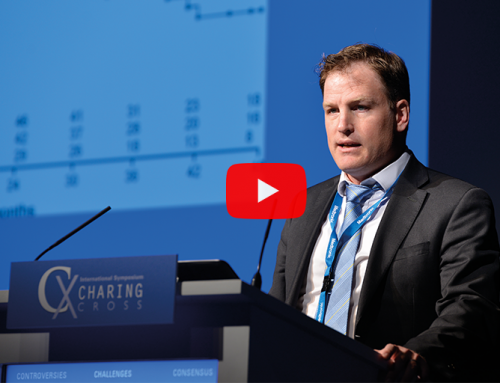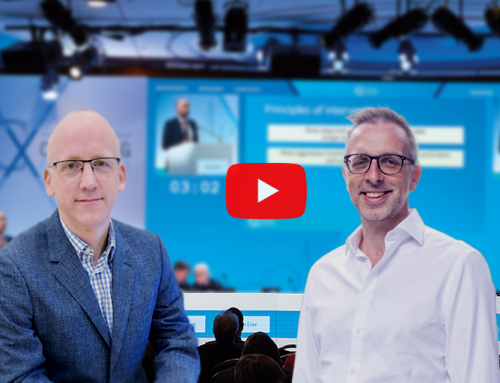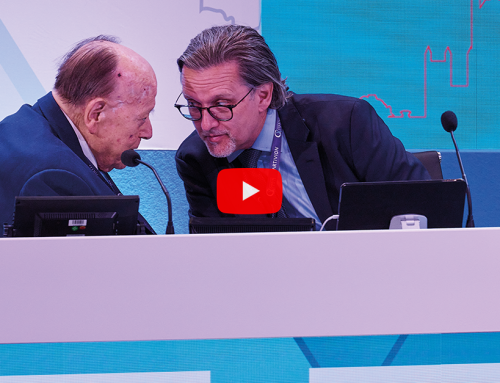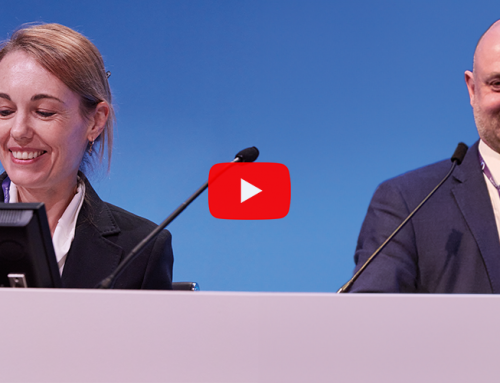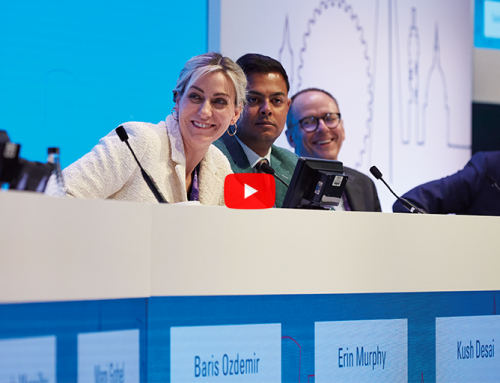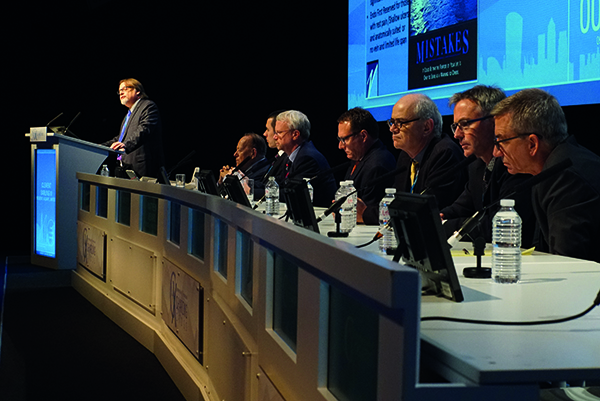
At the CX Great Debate held yesterday, vascular and endovascular surgery titans went head-to-head to debate the contentious topic “Endovascular-first strategy for critical limb ischaemia is a concept without evidence”. Arguing in favour of this motion were current Society for Vascular Surgery (SVS) president Clement Darling III (Albany, USA), BASIL trial principal investigator Andrew Bradbury (Birmingham, UK) and BEST-CLI trial principal investigator Matthew Menard (Boston, USA). Against the motion were vascular surgeon Peter Schneider (Honolulu, USA), angiologist Thomas Zeller (Bad Krozingen, Germany), and interventional radiologist Andrew Holden (Auckland, New Zealand)—all three are world renowned in their respective specialties.
A vote held at the session saw 60% of the voters backing the motion “Endovascular-first for critical limb ischaemia is a concept without evidence”.
Sharpening his metaphorical scalpel, Andrew Bradbury (Birmingham, UK), insisted that the only “reasonable, logical and unbiased” conclusion that can be drawn from the existing data on surgical vs. endovascular approach is that patients presenting with critical limb ischaemia due to femoropopliteal or infrapopliteal disease, and who can have vein bypass, should be offered vein bypass. Further, outside of ongoing randomised controlled trials, an endovascular-first revascularisation strategy should be reserved for those patients who cannot have vein bypass, he said.
Referring to the BASIL (Bypass versus Angioplasty in Severe Ischaemia of the Leg) trial, the only published randomised controlled trial of endovascular treatment against bypass in critical limb ischaemia due to infrainguinal disease, Bradbury, who was BASIL’s chief investigator, reminded the audience that it showed that in most patients who live for more than two years the outcome with bypass was better in terms of amputation-free survival and overall survival.
“People often say to me that BASIL is an old trial and is no longer relevant, but the question is: Are the BASIL-1 endovascular outcomes still relevant? I would say very much so, and if anything, I would suggest that the results from endovascular studies now are not quite as good as what we saw in the BASIL trial for a number of reasons,” Bradbury stated.
Further, he pointed out that while the BASIL-1 infrapopliteal subgroup results do not all meet standard criteria for statistical significance, the direction of the effect consistently favours bypass and the confidence intervals rule out the possibility of clinically important effects in favour of plain balloon angioplasty over vein bypass in this subgroup.
As for whether an endovascular procedure should be done prior to bypass, Bradbury pointed to research from the European Journal of Vascular Surgery that showed that clinical outcomes following primary bypass were significantly better than in patients undergoing secondary bypass after a failed endovascular intervention. It advised that prior to treating patients with clinical limb ischaemia with primary balloon angioplasty, clinicians should consider that if this should fail, the outcome of attempted subsequent bypass is likely to be significantly worse than if primary bypass were attempted.
Acknowledging the need for additional data, which is currently being collected in BASIL-2 and BASIL-3 and BEST-CLI, Bradbury maintained that it is clear that those patients who can have a vein bypass should have a vein bypass.
Adding to the debate against an endovascular-first strategy, Matthew Menard (Boston, USA) drew a parallel to the world of cancer care, suggesting that few in the audience would be comfortable with any oncologist who espoused a chemotherapy-first approach for all cancer patients.
Choosing one word to demonstrate his point, Menard argued that those who supported an endovascular-first strategy did so based not on evidence but rather their own personal “bias”.
He cited a recent meta-analysis published in the American Heart Journal that he said “concluded that there was a paucity of high-quality data to guide clinical decision-making in CLI”. He said that the “BEST-CLI trial is simply attempting to demonstrate which of the two treatment strategies—open surgical bypass or endovascular therapy—has the best value”, which is of particular importance given rapidly and “persistently rising health care costs”. He quoted data from Vogel et al describing over 13,000 US Medicare patients undergoing infra-popliteal endovascular intervention, indicating a 30-day mortality of 7%, 30-day rehospitalisation rate of 30% and 30-day amputation rate of 24%. He contrasted these numbers with work by Pomposelli et al describing their experience with over 1,000 patients undergoing dorsalis pedis bypass grafting, where the 30-day mortality was 0.9%, and the 5-year amputation rate was 22%. “You have a real-world endovascular 30-day amputation rate of 24% and a bypass surgery 5-year amputation rate of 22%… you decide.”
He went on to highlight the problems of many of the studies in the endovascular literature, among them “short follow-up periods, mixing of claudicants with limb ischaemia patients, prevalent sponsor bias, and inappropriate endpoints”. He zeroed in on the flaws inherent to the commonly used endpoints of target lesion revascularisation, and target vessel revascularisation”, which he said “are highly subjective”.
He emphasised the dangers of an endo-first strategy, saying “the potential for harm is real, and is to date not fully characterised. Recurrence of symptoms in short time intervals is a frequent occurrence, and there is significant expense and completely unproven cost-effectiveness”. In short, “there is zero data to support an endovascular-first strategy, and it is unsound medical practice to pretend that there is,” Menard argued. He concluded by accenting the need for ongoing collaboration between the different disciplines treating CLI. “All of us, collectively, need to put the turf wars of the last two decades behind us and, systematically and scientifically, work to clarify the appropriate role for open and endovascular procedures,” he stated.
Bringing up the rear for the winning side, Clement Darling III (Albany, USA and president Society for Vascular Surgery) concluded that there is no survival benefit in the endovascular-first approach and better limb salvage in bypass surgery, which also costs the same, or less, than the endovascular-first approach. He said that bypass should be the first option in patients with significant tissue loss, and that the endovascular-first approach should be reserved for those with rest pain or shallow ulcers and those who are anatomically suited or have no vein and/or a limited life span.
Darling added that the ideal therapy should “really be effective and durable and have high limb salvage, low mortality and low morbidity. Unfortunately, this is not seen in the current endovascular-first approach data.”
Leading the charge for the interventionalists was Thomas Zeller (Bad Krozingen, Germany) who stated that the arguments of the against endovascular-first approach were mostly based on the BASIL trial—an “old fashioned, outdated and underpowered” trial. “What I have heard so far is not that much evidence to back the use of surgery as a front-line strategy for critical limb ischaemia,” he said.
BASIL randomised patients to receive either bypass or balloon angioplasty, but angioplasty is “definitely an outdated endovascular interventional method today,” said Zeller. Further, in the trial, patients were analysed on the basis of their randomisation and not on the basis of treatment, he added, noting that 15% of patients allocated to surgery did not undergo surgery but analysed as being whose data were analysed as being treated with a bypass. The crossover in the endovascular cohort is not as marked, indicating that even if you want to treat a patient with surgery, a relevant number of patients are unfit for open repair. This is in contrast to the endovascular approach, which can be applied to everybody,” he said.
He also knocked on the head the data for survival benefit that was obtained from BASIL noting that the trial was powered for follow-up to the two-year endpoint and not for the five-year endpoint. “Even if the curves appear to diverge in favour of the bypass group, you have to take into account the number at risk for the analysis at five years,” said Zeller, noting that they were too small to draw definitive conclusions about the superiority of one method over the other. “{to do this] is nonsense, said Zeller, stating that a post-hoc analysis based on an underpowered study could not be used to conclude anything definitive.
After dismantling the findings of the BASIL trial, he carefully constructed the argument that open surgery is not the gold standard for the treatment of critical limb ischaemia anymore using more recent studies such as the SPINACH (Surgical reconstruction vs. peripheral intervention in patients with critical limb ischemia) study. Iida et al found that three-year amputation-free survival was not different between surgical reconstruction and endovascular therapy in a critical limb ischaemia population. “We have at least comparable amputation-free survival for endovascular therapy and at least comparable wound healing rates for endovascular therapy. The endovascular approach is less invasive and has no intensive care unit stay. It results in faster ambulation and shorter hospital stay. It allows the optimisation of outflow (pedal arteries) and many patients need to crossover to receive this treatment due to the anatomical requirements for surgery,” Zeller concluded.
Andrew Holden (Auckland, New Zealand) maintained that to debate whether evidence supports a surgical bypass vs. endovascular-first approach “implies that both treatment modalities are in clinical equipoise”. However, said Holden, in critical limb ischaemia clinical equipoise does not exist because endovascular revascularisation is constantly evolving due to improvements in equipment, advances in the concept of vessel preparation, antirestenosis strategies and procedural improvements, angiosome-guided interventions and new developments in intraprocedural monitoring of adequate revascularisation.
Holden also said it was important to bust the myth that endovascular was “not a free pass” and that failed endovascular cases have a significantly worse outcome than those treated early with bypass.
“The vast majority of critical limb ischaemia patients is offered endovascular revascularisation first. It is important to remember that rest pain (Rutherford 4 critical limb ischaemia) often responds to revascularising single level disease and almost never requires surgical bypass. In the small subset of patients who have a good life expectancy, large wounds and a venous conduit, it is reasonable to consider surgical bypass and we must established scoring tools to allow us to identify this subset of patients.
“The Investigators of BEST-CLI and BASIL-2 should be congratulated on their endeavours. However, these trials will not significantly change clinical practice because there is not clinical equipoise between the treatments being compared and one of the therapies is continuing to improve and evolve. There is also clearly ample evidence for an endovascular-first approach to critical limb ischaemia in most patients, so further trials are not going to change that,” pointed out Holden.
Peter A Schneider (Honolulu, Hawaii) then picked up the endovascular baton and pointed out that the advantage of bypass relied largely upon the improved patency it conferred and that it was usually a definitive treatment. However, bypass also had disadvantages with regard to the morbidity and mortality associated with the procedure and the time patients need to stay in hospital after receiving the procedure. “In order to perform a bypass, there needs to be adequate vein. The procedure is typically to a single target and there can be anatomic limitations to the target site,” Schneider explained.
In 2018, there is currently level one and other evidence backing an endovascular-first approach to treat critical limb ischaemia that is just as strong as the evidence for bypass, exhorted Schneider. “Endovascular interventions rarely burn bridges and surgery is not the answer in most patients. The preponderance of evidence favours the endovascular-first approach for critical limb ischaemia, and those who can do both, more often than not select endovascular first,” he concluded.



